Last Chance to Catch NYC's Holiday Notalgia Train
We met the voices of the NYC subway on our nostalgia ride this weekend!


July 10th, 2016 marked the 160th birthday of Serbian-American inventor, engineer and physicist, Nikola Tesla, regarded as one of the most important figures of the 19th and 20th centuries. In 1884, a 28-year-old Tesla was hired by Thomas Edison, and moved from his home country in the Austrian Empire (present day Croatia), and would go on to live and work in New York City for 60 years. Tesla was credited with the advancement and creation of a number of important inventions, but unfortunately, others would often be credited for his work. Here is a list of the top 10 places to find Nikola Tesla in New York City.
As Untapped Cities previously reported, Tesla lived at the New Yorker Hotel for the last decade of his life in rooms 3327 and 3328, which served as his bedroom and study, respectively. Prior to his 10-year long stay at the New Yorker, Tesla lived at the Waldorf-Astoria, where he was known for throwing grand dinners for his friends and acquaintances, including author Mark Twain. Though he enjoyed fame and fortune for most of his life, he spend 1933 to 1943 in debt.
On January 7, 1943, a housekeeper found Tesla dead in his room, after she ignored the “do not disturb” sign on his door.In 2001, the Tesla Memorial Society installed plaques on the outside of the New Yorker and on the doors of his hotel room which list a few of his best-known accomplishments. For those who can’t make the trip to the hotel, the 3D visualization company Matterport offers a virtual tour of Tesla’s rooms in their current renovated state, created by Real Virtual Zone.
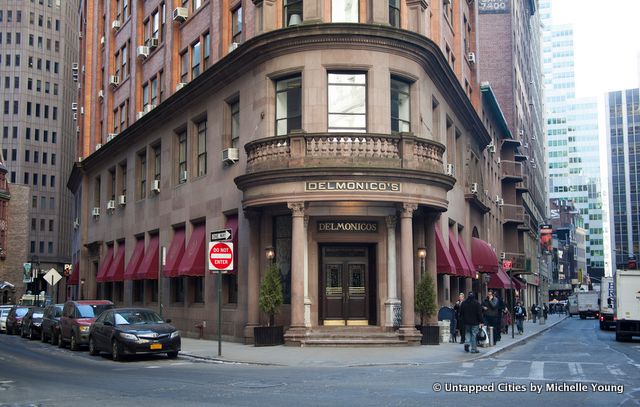
The original chain of Delmonico’s restaurants was owned and operated by the family of the same name during the 19th and early 20th centuries. According to the website Tesla Universe, Tesla”invariably” ate his meals at Delmonico’s and spent time at the café during the evenings. There were Delmonico restaurants across Manhattan including the original and most famous location at 2 South Williams Street. Other famous patrons of the restaurant include J.P. Morgan, Charles Dickens, Arthur Sullivan, Jenny Lind and Theodore Roosevelt.

Tesla’s first lab was located at 89 Liberty Street
During his 60 years of working in New York, Tesla moved to a number of laboratories throughout the city. The Gotham Center for New York City History details a number of Tesla’s labs in the article, ‘Places of Invention: Nikola Tesla’s Life in New York.’ While digging ditches for the Western Union Telegraph Company, Tesla grabbed the attention of his supervisor Alfred S. Brown, who introduced him to Charles Peck, a lawyer who sold his Mutual Union Telegraph Company to Jay Gould. Brown and Peck became partners and rented a lab for Tesla in the Financial District at 89 Liberty Street. While at Liberty Street, Tesla perfected the design for his AC motor and earned his first patent.
In 1889, after returning from a brief time in Pittsburgh, Tesla rented a new laboratory at 175 Grand Street, after learning that German physicist Heinrich Hertz had detected radio waves. The discovery excited Tesla and it was at this lab that he created the Tesla coil, a high-voltage, high-frequency transformer.
His next laboratory at 33-35 South Fifth Avenue, which is today LaGuardia Place, was where he completed his most important work on wireless lighting. He gave demonstrations to his friends including famed architect Stanford White and author Mark Twain. But the lab caught on fire in 1895, and he lost all the plans and projects he was working on. Tesla fell into a deep depression, but with the support of his friends and “electroshock treatments from his coils,” he overcame his depression.
In July of the same year, Tesla rented out yet another lab, this time located at 46 East Houston Street. Here he learned about X-rays, developed a radio-controlled boat and worked on a system to transmit power around the world without using wires. This resulted in Tesla building a power station at Wardenclyffe on Long Island.
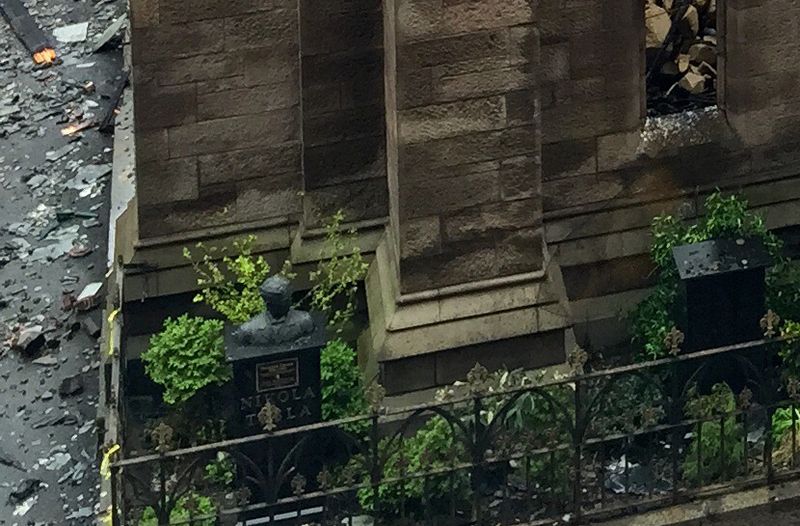
Photo via Marissa Marivelli for HDC_NYC & Untapped Cities
On West 25th Street, situated between Broadway and Avenue of the Americas, is the Serbian Orthodox Cathedral of St Sava. As previously covered by Untapped, the cathedral was originally built from 1850 to 1855 and was part of the Episcopalian Trinity Chapel Complex that included St. Sava, formerly known as Trinity Chapel, Trinity Chapel School and the Clergy House. The Trinity Chapel Complex was designed by Richard Upjohn, who was also responsible for rebuilding Trinity Church. In 1942, the church was sold to the Serbian Eastern Orthodox Parish, and in 1944 it was renamed the Serbian Orthodox Cathedral of St. Sava.
Due to his Serbian heritage, Tesla and his legacy have been strongly connected to St. Sava. In 1993, the cathedral commemorated the 50th anniversary of Tesla’s death and in 2007, a bust designed by Serbian artist, Marina Zivic, was dedicated in his honor. In May 2016, there was a devastating fire at St. Sava, and though the fire destroyed much of the cathedral in its wake, Tesla’s bust remained unscathed.
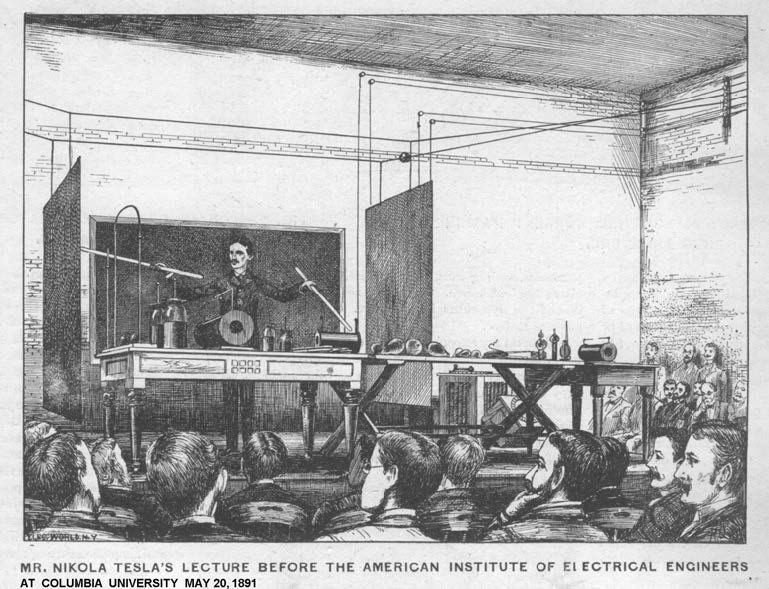
Photo via Wikimedia Commons/Electrical World and Engineer
While Tesla worked at his lab at 175 Grand Street, he invented the Tesla coil around the year 1891. That same year, he demonstrated how his newest invention could be used for wireless lighting at the spring meeting of the American Institute of Electrical Engineers. The demonstration took place at Columbia University’s old location at 49th Street between Madison Avenue and Fourth Avenue.
According to the Gotham Center for New York City History, the Tesla coil was connected to two large zinc sheets that was suspended from the ceiling. He then took two long gas-filled tubes and stood between the zinc sheets. He waved the tubes around and they subsequently started to glow due to the electrical field Tesla set up. Although the Columbia University campus moved uptown to its current location at 116th Street and Broadway, Tesla will forever be ingrained in the school’s history.
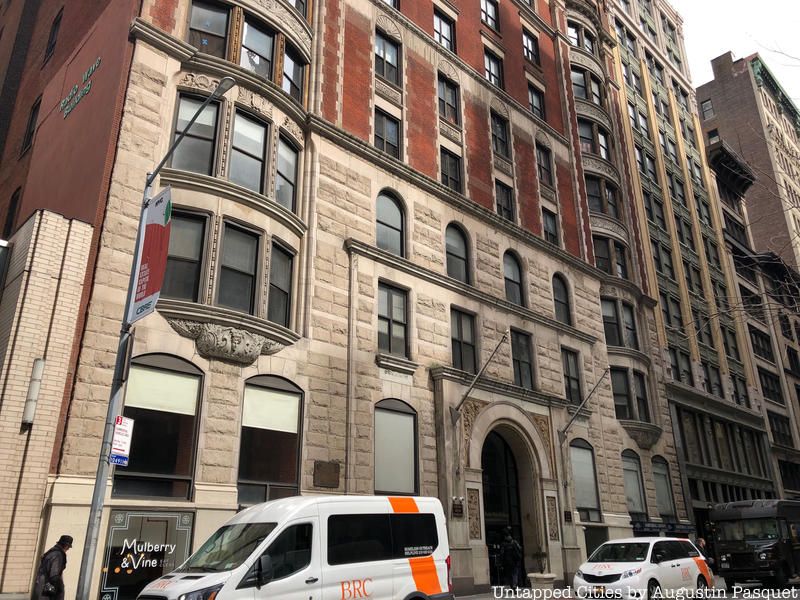
According to the Tesla Society, Tesla lived and worked at the Gerlach Hotel, currently known as the Radio Wave Building, before the end of the 19th century. The Radio Wave Building was named for the experiments he conducted with radio waves in 1896 while staying at the hotel. His experiments would later lead to the birth of the radio, though Italian inventor Guglielmo Marconi was credited with the radio’s invention after Tesla lost his patent. In 1977, the Yugoslav-American Bicentennial Committee dedicated a plaque to Tesla which says his “discoveries in the field of alternating electric current contributed to the advancement of the United States and the rest of the world.”
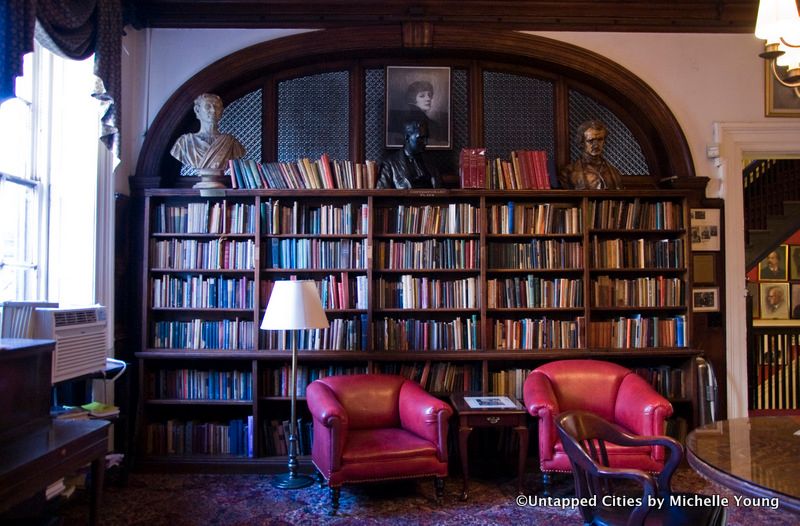
In 1847, 19th-century Shakespearean actor Edwin Booth, older brother of the notorious John Wilkes Booth, purchased a mansion at 16 Gramercy Park and started The Players Club. The original purpose of the club was twofold: to renew the tarnished Booth name following the assassination of President Lincoln, and to provide a social setting for up-and-coming artists to socialize with society’s elite. Tesla was one of many notable members of the Players Club, which included big names like Stanford White, who built the Gramercy Park mansion, Carol Burnett, Ethan Hawke and Jimmy Fallon.
As members only club, visitors are not allowed to enter. But Untapped Cities is hosting a tour of the Players Club on Friday, July 29, from 6 to 7 pm. Tickets for this exclusive event can be purchased below.
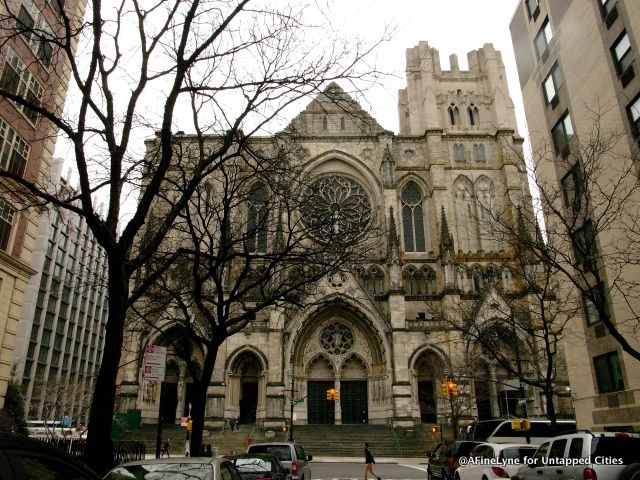
Tesla died on January 7, 1943, and his funeral was held at the Cathedral of Saint John the Divine on January 12. According to the New York Times, 2,000 people attended his funeral. The list of high-profile funeral attendees included inventors, Nobel Prize winners and high ranking officials of the Yugoslav and New York government. Two days before Tesla’s funeral, then-Mayor Fiorello LaGuardia recorded a live eulogy for the inventor, which was broadcast over New York City radio. A black and white image from Tesla’s funeral shows his casket covered with both the flags of the United States and Yugoslavia, a tribute to both of the countries he called home. His ashes were placed in a golden sphere and are kept at the Tesla Museum in Belgrade, Serbia.

Just outside Bryant Park is Nikola Tesla Corner, a memorial to Tesla at the corner Avenue of the Americas at West 40th Street. During his lifetime, Tesla enjoyed feeding and spending time with pigeons, reportedly feeding thousands of the city birds and also caring for some of them. According to Atlas Obscura, the city named the intersection Nikola Tesla Corner in 1994. Folklore says that Tesla harbored romantic feelings for an all-white pigeon saying “I loved that pigeon as a man loves a woman, and she loved me. As long as I had her, there was purpose to my life.”
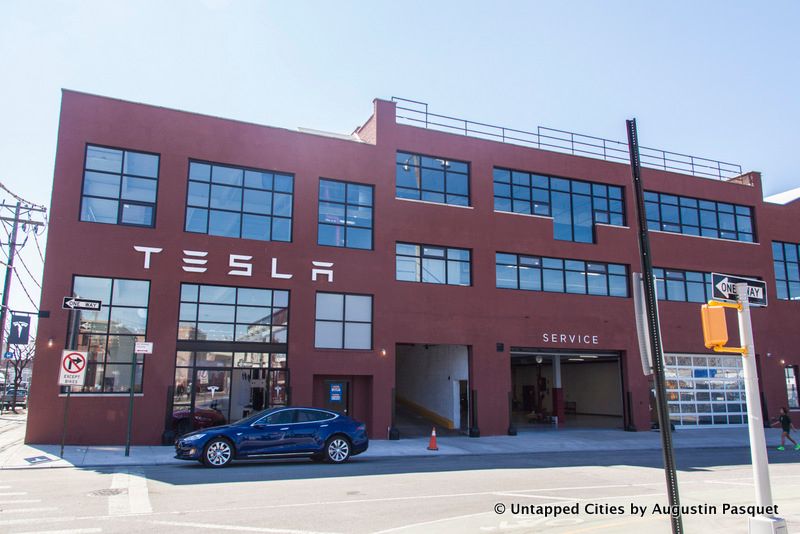
Nikola Tesla inspired the name of Tesla Motors, the $53 billion company founded by Silicon Valley entrepreneur Elon Musk in 2003 after the company’s engineers first designed a powertrain for a sports car built around Tesla’s patented AC induction motor.
In April 2016, a new Tesla Motors showroom opened in Red Hook, Brooklyn. The and has sold over 125,000 cars worldwide. The Tesla showroom is the second of its kind in New York, with the first one located in Chelsea. The 40,000 square foot showroom is located at 160 Van Brunt Street and features two Tesla Motor vehicles, a model of “Tesla’s famously lightweight chassis,” and a design studio where visitors can customize a car of their choice.
Though electric cars are not as popular in New York as they are in states like California, Tesla is working to increase its popularity by building more charging stations around the city and partnering with a company called Luxe that picks up the vehicle and returns it fully charged.

Next check out Tesla Pushed Into Brooklyn With New Showroom on Red Hook Waterfront and Step Inside Nikola Tesla’s Hotel Room at the New Yorker in 3D. Connect with the author @jen_bagcal.
Subscribe to our newsletter